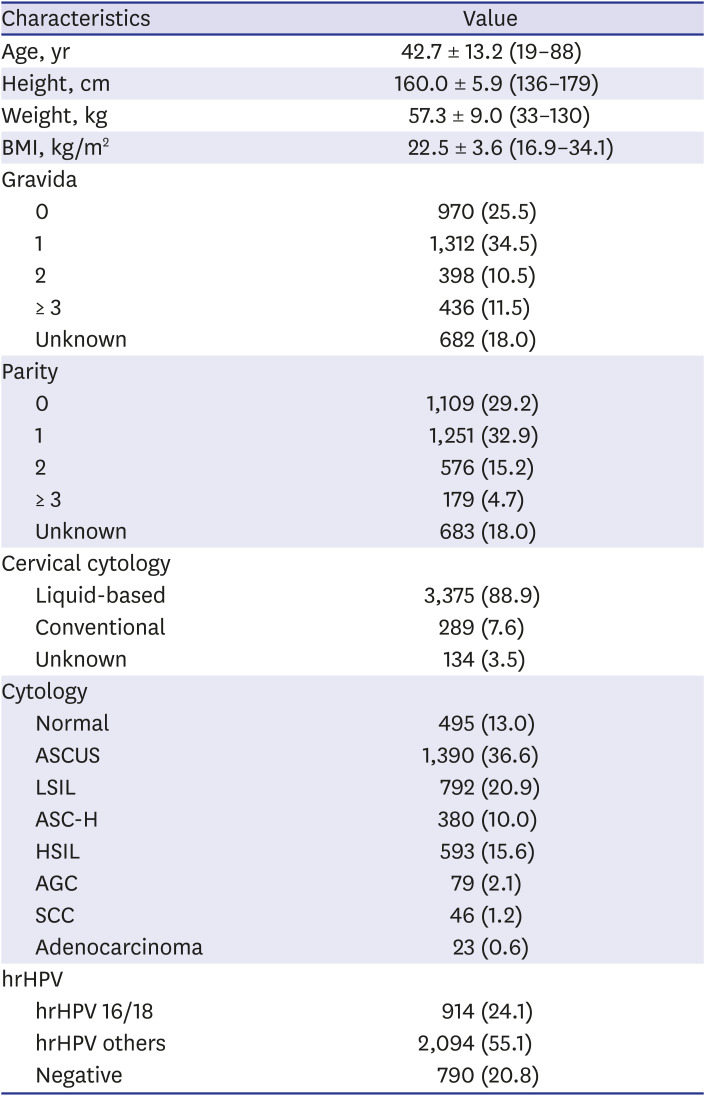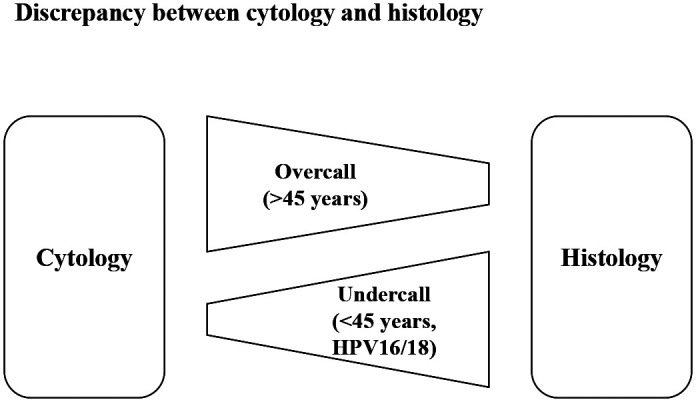1. Moss E, Redman C, Arbyn M. Accuracy of colposcopy-directed punch biopsies. BJOG. 2013; 120(7):903. PMID:
23659332.

2. Guan P, Howell-Jones R, Li N, Bruni L, de Sanjosé S, Franceschi S, et al. Human papillomavirus types in 115,789 HPV-positive women: a meta-analysis from cervical infection to cancer. Int J Cancer. 2012; 131(10):2349–2359. PMID:
22323075.

3. Min KJ, Lee YJ, Suh M, Yoo CW, Lim MC, Choi J, et al. The Korean guideline for cervical cancer screening. J Gynecol Oncol. 2015; 26(3):232–239. PMID:
26197860.

4. Hong DG, Seong WJ, Kim SY, Lee YS, Cho YL. Prediction of high-grade squamous intraepithelial lesions using the modified Reid index. Int J Clin Oncol. 2010; 15(1):65–69. PMID:
20087617.

5. Moss EL, Hadden P, Douce G, Jones PW, Arbyn M, Redman CW. Is the colposcopically directed punch biopsy a reliable diagnostic test in women with minor cytological lesions? J Low Genit Tract Dis. 2012; 16(4):421–426. PMID:
22669079.

6. Shumsky AG, Stuart GC, Nation J. Carcinoma of the cervix following conservative management of cervical intraepithelial neoplasia. Gynecol Oncol. 1994; 53(1):50–54. PMID:
8175022.

7. Castle PE, Gage JC, Wheeler CM, Schiffman M. The clinical meaning of a cervical intraepithelial neoplasia grade 1 biopsy. Obstet Gynecol. 2011; 118(6):1222–1229. PMID:
22105250.

8. Tverelv LR, Sørbye SW, Skjeldestad FE. Risk for cervical intraepithelial neoplasia grade 3 or higher in follow-up of women with a negative cervical biopsy. J Low Genit Tract Dis. 2018; 22(3):201–206. PMID:
29543686.

9. Joste NE, Crum CP, Cibas ES. Cytologic/histologic correlation for quality control in cervicovaginal cytology. Experience with 1,582 paired cases. Am J Clin Pathol. 1995; 103(1):32–34. PMID:
7817940.
10. Hong JS, Yi SW, Kang HC, Jee SH, Kang HG, Bayasgalan G, et al. Age at menopause and cause-specific mortality in South Korean women: Kangwha Cohort Study. Maturitas. 2007; 56(4):411–419. PMID:
17161927.

11. Gupta R, Hariprasad R, Dhanasekaran K, Sodhani P, Mehrotra R, Kumar N, et al. Reappraisal of cytology-histology correlation in cervical cytology based on the recent American Society of Cytopathology guidelines (2017) at a cancer research centre. Cytopathology. 2020; 31(1):53–58. PMID:
31535740.

12. Pimple SA, Amin G, Goswami S, Shastri SS. Evaluation of colposcopy vs cytology as secondary test to triage women found positive on visual inspection test. Indian J Cancer. 2010; 47(3):308–313. PMID:
20587908.

13. Nkwabong E, Laure Bessi Badjan I, Sando Z. Pap smear accuracy for the diagnosis of cervical precancerous lesions. Trop Doct. 2019; 49(1):34–39. PMID:
30222058.

14. Costa S, De Simone P, Venturoli S, Cricca M, Zerbini ML, Musiani M, et al. Factors predicting human papillomavirus clearance in cervical intraepithelial neoplasia lesions treated by conization. Gynecol Oncol. 2003; 90(2):358–365. PMID:
12893200.

15. Waddell CA. The influence of the cervix on smear quality. I: Atrophy. An audit of cervical smears taken post-colposcopic management of intraepithelial neoplasia. Cytopathology. 1997; 8(4):274–281. PMID:
9252745.

16. Halford J, Walker KA, Duhig J. A review of histological outcomes from peri-menopausal and post-menopausal women with a cytological report of possible high grade abnormality: an alternative management strategy for these women. Pathology. 2010; 42(1):23–27. PMID:
20025476.

17. So KA, Lee IH, Lee KH, Hong SR, Kim YJ, Seo HH, et al. Human papillomavirus genotype-specific risk in cervical carcinogenesis. J Gynecol Oncol. 2019; 30(4):e52. PMID:
31074234.

18. Perkins RB, Guido RS, Castle PE, Chelmow D, Einstein MH, Garcia F, et al. 2019 ASCCP risk-based management consensus guidelines for abnormal cervical cancer screening tests and cancer precursors. J Low Genit Tract Dis. 2020; 24(2):102–131. PMID:
32243307.
19. Lee DH, Hwang NR, Lim MC, Yoo CW, Joo J, Kim JY, et al. Comparison of the performance of Anyplex II HPV HR, the Cobas 4800 human papillomavirus test and Hybrid Capture 2. Ann Clin Biochem. 2016; 53(Pt 5):561–567. PMID:
26486441.

20. Choi JJ, Kim C, Park H. Peptide nucleic acid-based array for detecting and genotyping human papillomaviruses. J Clin Microbiol. 2009; 47(6):1785–1790. PMID:
19369432.

21. Moon JH, Jeong K, Kim K, Lee C, Jin MS, Ryu HS. Comparison of clinical performance of two high-throughput liquid bead microarray assays, GeneFinder and CareGENE, for cervical screening in the general population. Arch Virol. 2019; 164(11):2699–2706. PMID:
31435867.

22. Cai X, Guan Q, Huan Y, Liu Z, Qi J, Ge S. Development of high-throughput genotyping method of all 18 HR HPV based on the MALDI-TOF MS platform and compared with the Roche Cobas 4800 HPV assay using clinical specimens. BMC Cancer. 2019; 19(1):825. PMID:
31438998.

23. Park Y, Lee E, Choi J, Jeong S, Kim HS. Comparison of the Abbott RealTime High-Risk Human Papillomavirus (HPV), Roche Cobas HPV, and Hybrid Capture 2 assays to direct sequencing and genotyping of HPV DNA. J Clin Microbiol. 2012; 50(7):2359–2365. PMID:
22518863.

24. Hesselink AT, Sahli R, Berkhof J, Snijders PJ, van der Salm ML, Agard D, et al. Clinical validation of Anyplex™ II HPV HR Detection according to the guidelines for HPV test requirements for cervical cancer screening. J Clin Virol. 2016; 76:36–39. PMID:
26809131.

25. Samiee Rad F, Ghaebi M, Zarabadipour S, Bajelan A, Pashazade F, Kalhor M, et al. Comparison of diagnostic methods in detection of squamous cell abnormalities in Iranian women with abnormal Pap's smear test and associated demographic and issues. Iran J Pathol. 2020; 15(2):106–116. PMID:
32215026.

26. Long MJ, Wu FX, Li P, Liu M, Li X, Tang H. MicroRNA-10a targets CHL1 and promotes cell growth, migration and invasion in human cervical cancer cells. Cancer Lett. 2012; 324(2):186–196. PMID:
22634495.

27. Ye J, Cheng XD, Cheng B, Cheng YF, Chen XJ, Lu WG. MiRNA detection in cervical exfoliated cells for missed high-grade lesions in women with LSIL/CIN1 diagnosis after colposcopy-guided biopsy. BMC Cancer. 2019; 19(1):112. PMID:
30700264.

28. Killeen JL, Dye T, Grace C, Hiraoka M. Improved abnormal Pap smear triage using cervical cancer biomarkers. J Low Genit Tract Dis. 2014; 18(1):1–7. PMID:
23760145.









 PDF
PDF Citation
Citation Print
Print




 XML Download
XML Download